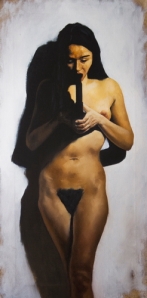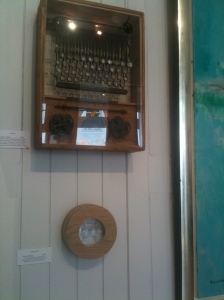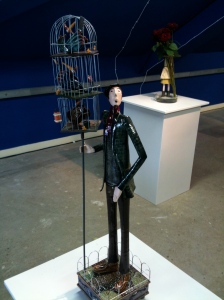Sunday Morning.
Our luck was in again on this fine Sunday morning. If earthenware was the theme for yesterday, today seems to be sponsored by more ads for tarot, past life regressions, aromatherapy and Indian head massages than I’ve ever seen, either in this life or any previous ones. Sunday morning was spent mostly along James Street which runs through Pittenweem.
49. Open Exhibition. As you’d expect, a real mixed bag of styles, techniques, media and capability. Features two of Julie’s collages which hold their own quite comfortably. Not much in the way of red dots which doesn’t bode entirely well but it does mean that we might be able to put our hall back to the way it was once this is all over.
88. Winton, Demarco & Newman. Feels like a proper City gallery. It used to be a car showroom so it’s über spacious and the empty spaces were filled with Spanish guitar music. Susan Winton’s mixed media abstract landscapes were striking as were the numberous Richard Demarco pencil (I think) illustrations, which look like film noir movie storyboards. Terry Ann Newman, I just don’t get. At all. While we were browsing, Richard Demarco turned up with a couple of Californian types to sit at a table and discuss the Festival (not that I was eavesdropping). However, while I was eavesdropping, I heard Mr Demarco mention that he thought it was a shame that most artists use the same venues every year and they should mix it up to keep things fresh. I tend to agree, but more importantly, I think artists shouldn’t exhibit the same stuff year in, year out which quite a few of them do.
50. Church Hall. This is split into three venues. The main hall is taken up with some Capability Scotland artwork, featuring work by an artist called Garland who only draws, with felt tips, largely identical topless women; particularly his nurses. It’s impossible not to smile. Upstairs, one of the smallest venues has some of the biggest paintings. Morag Muir’s work is full of Persian colours and influence but the subject matter is typically contemporary (for example, a tin of Quality Street). The annexe is a threads and textiles exhibition that draws on influence from Native and Latin American as well as more homely Gaelic hues.
51. Sheila Caldwell. This was the first venue that was obviously in someone’s house. Mostly woodland watercolours that I thought my mum would love but a bit too safe and obvious for my tastes.
56. John Gifford. With the smell of a nearby barbecue on a Sunday lunchtime, it was tricky to concentrate on John’s pictures of the East Neuk. This was the first venue that exhibited artwork of predominantly local inspiration. Again, maybe a bit standard, and his more impressionist work was, funnily enough, more impressive even if they were thinner on the ground.
Sunday Afternoon.
After a seafood lunch at the Heron Bistro, we strolled up West Braes where we knew we’d be in for a treat or two although unfortunately, the guy who sculpted a G2 Mac out of a block of granite was nowhere to be found this year.

Angie Turner
33. Angie Turner & Suzi Morrow. One of our favourites from last year, we found Angie Turner in sparkling form. It would be hard to visit her and not come away feeling that all is right in the world and this little corner of it is populated with genuinely lovely people. We bought another fairground horse as a companion to last year’s. Angie takes obvious inspiration from circus and fairground themes and her abstract work is fabulous, making me wish we’d stuck a couple of hundred aside to pick one up. It’s abstract working as abstract should, requiring a little effort on behalf of the viewer to piece the puzzle together. Sadly, Suzi Morrow, who we also liked very much last year, had to pull out this year and we didn’t catch the names of the other artists sharing the venue in her stead, although they were just as impressive. Huge screenprints taking inspiration from New York and Dundee (we laughed with the artist at the unusual fusion) and very emotionally affecting sculptures (an old typewriter with sepia Victorian faces for keys) really threatened to overwhelm my poor brain, but in a nice way! Without a doubt, Venue 33 has been the most enjoyable so far and we’ll enjoy a second visit later in the week for photos and to right the wrongs of forgotten names.
After a brief break, we found ourselves chalking off some of the venues along the High Street, starting with one that gets plenty of column inches in the Festival Programme.
7. Masahiro Kawanaka is a Japanese installation artist. For this exhibit, he’s stretched audio tape across a garage, creating a moving wall of brown tape which flickers in the wind. That’s it. There were many raised eyebrows and not much interest in the chair that had been, perhaps optimistically, placed in front of the tape for those wanting an extended view. I hate dismissing the unusual just because it’s unusual, but I honestly can’t say what they artist was hoping to achieve with the work.
37. Jean Dakin, Doris French & Nicky Fraser. Doris French had sold all of her quilted pictures, just like last year. Hardly surprising, but a little disappointing as her work is honest and charming. Jean Dakin presented lovely loose pastels of African savannah and townships. Nicky Fraser’s work is a little harder to place and pigeonhole but the bold, almost cubist, primary colour representation of busy harbours certainly hits you between the eyes. A lot packed into this garage.
14. Elizabeth Shepherd. Etchings. Accompanied as they were by disturbing sci-fi music, the whole thing was rather surreal. Elizabeth herself read a book in the corner of the room, which she’s perfectly entitled to do, but I find when the artist takes the time to engage and converse with the audience it’s a) a more interesting experience and b) we have a better chance of understanding the work. Neither happened and I recall neither happening last year, either.
18. Maureen Traquair. As we discovered, Maureen owns the venue and, as it turns out, the shop underneath. Some very striking photography perhaps just a little usurped by the astonishing views of the Firth of Forth from the window where a trawler was being pestered by a million gulls.

The Little Gallery
13. The Little Gallery. This has to be the most wonderful building in the festival, so much so it’s hard to remember to look at the art. There’s no one artist here so it’s a bit of a hotch-potch and I’ve got to say nothing much caught my eye in either a good or bad way … but what an amazing room. The main part of the building used to be a fisherman’s cottage and fishermen back in the day were a bunch of short-arses so there are very low ceilings throughout. Then, through one door, it’s like stepping into a massive cavern, albeit one with an attractive mezzanine and I half-expected to find Nicholas Cage searching for some lost treasure behind the ottoman.
6. The Fisher Gallery. We finished the afternoon in another favourite haunt. There’s so much to admire in this permanent, year-round gallery and pound for pound it probably has more fantastic work than most. This year, we were particularly taken by Lynn Muir’s Burtonesque art from driftwood. Jan Fisher’s masterful use of watercolour never disappoints and she captures some of my favourite Neuk themed seascapes. It’s all good, though.
 ing behind it, so quite how it took four days for us to find it, I’m not quite sure. I am, however, very glad I did. Hendry’s work is staggeringly, achingly beautiful. A lot of it, though, isn’t particularly easy to look at, as the example perhaps shows. These are scenes from a blank planet. Nude women with guns. Nude men in gravitational struggles. They all combine to provide a very affecting collection that I found quite difficult to detach myself from. I absolutely loved it. More of Hendry’s work can be seen here.
ing behind it, so quite how it took four days for us to find it, I’m not quite sure. I am, however, very glad I did. Hendry’s work is staggeringly, achingly beautiful. A lot of it, though, isn’t particularly easy to look at, as the example perhaps shows. These are scenes from a blank planet. Nude women with guns. Nude men in gravitational struggles. They all combine to provide a very affecting collection that I found quite difficult to detach myself from. I absolutely loved it. More of Hendry’s work can be seen here.



 27. Mark Bannerman. Surreal 3D renderings. The Scotch Pie Fight has proved very popular. The images have a strange Victorian freak show feel, making them even more interesting.
27. Mark Bannerman. Surreal 3D renderings. The Scotch Pie Fight has proved very popular. The images have a strange Victorian freak show feel, making them even more interesting.



